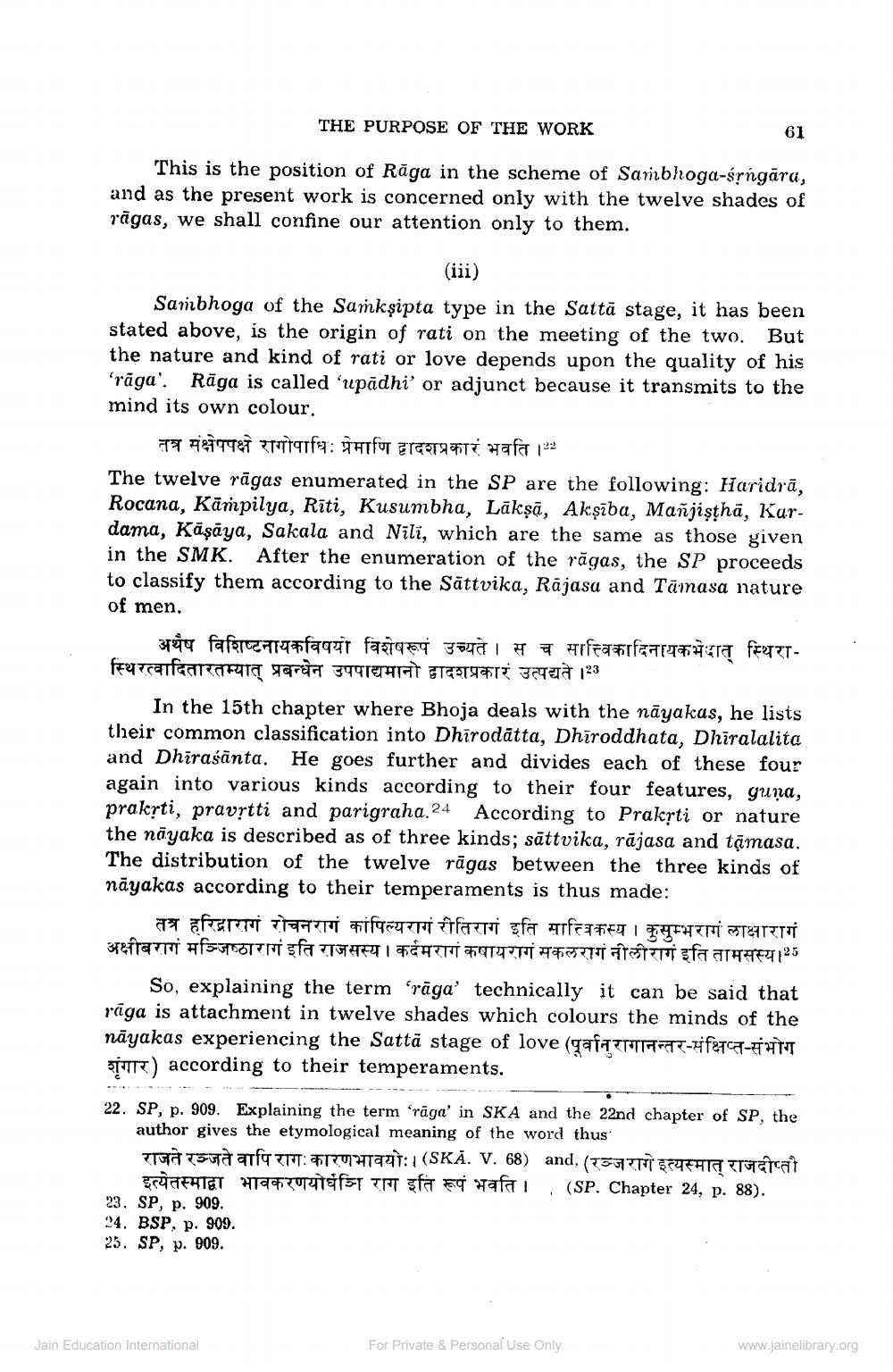________________
THE PURPOSE OF THE WORK
This is the position of Raga in the scheme of Sambhoga-śṛngāra, and as the present work is concerned only with the twelve shades of rāgas, we shall confine our attention only to them.
(iii)
Sambhoga of the Samkṣipta type in the Satta stage, it has been stated above, is the origin of rati on the meeting of the two. But the nature and kind of rati or love depends upon the quality of his 'rāga'. Raga is called 'upadhi' or adjunct because it transmits to the mind its own colour.
तत्र संक्षेपपक्षे रागोपाधिः प्रेमाणि द्वादशप्रकारं भवति ।
The twelve rägas enumerated in the SP are the following: Haridrā, Rocana, Kampilya, Rīti, Kusumbha, Lākṣā, Akşība, Mañjiṣṭhā, Kardama, Kaşaya, Sakala and Nili, which are the same as those given in the SMK. After the enumeration of the ragas, the SP proceeds to classify them according to the Sättvika, Rajasa and Tamasa nature
of men.
61
अथैष विशिष्ट नायक विषयो विशेषरूपं उच्यते । स च सात्त्विकादिनायकभेदात् स्थिरास्थिरत्वादितारतम्यात् प्रबन्धेन उपपाद्यमानो द्वादशप्रकारं उत्पद्यते | 23
In the 15th chapter where Bhoja deals with the nayakas, he lists their common classification into Dhirodatta, Dhiroddhata, Dhiralalita and Dhiraśānta. He goes further and divides each of these four again into various kinds according to their four features, guna, prakrti, pravṛtti and parigraha.24 According to Prakṛti or nature the nayaka is described as of three kinds; sättvika, rājasa and tamasa. The distribution of the twelve rāgas between the three kinds of nayakas according to their temperaments is thus made:
तत्र हरिद्वारागं रोचनरागं कांपिल्यरागं रीतिरागं इति सात्विकस्य । कुसुम्भरागं लाक्षारागं अक्षीरागं मञ्जिष्ठारागं इति राजसस्य । कर्दमरागं कषायरागं सकलरागं नीलीरागं इति तामसस्य । 25
So, explaining the term 'raga' technically it can be said that raga is attachment in twelve shades which colours the minds of the nāyakas experiencing the Sattā stage of love (पूर्वानुरागानन्तर-संक्षिप्त-संभोग ) according to their temperaments.
22. SP, p. 909. Explaining the term 'raga' in SKA and the 22nd chapter of SP, the author gives the etymological meaning of the word thus
राजते रञ्जते वापि रागः कारणभावयोः । (SKā. V. 68 ) and ( रञ्ज रागे इत्यस्मात् राजदीप्ती इत्येतस्माद्वा भावकरणयोर्धनि राग इति रूपं भवति ।
(SP. Chapter 24, p. 88).
23. SP, p. 909.
24. BSP, p. 909.
25. SP, p. 909.
Jain Education International
For Private & Personal Use Only
www.jainelibrary.org




